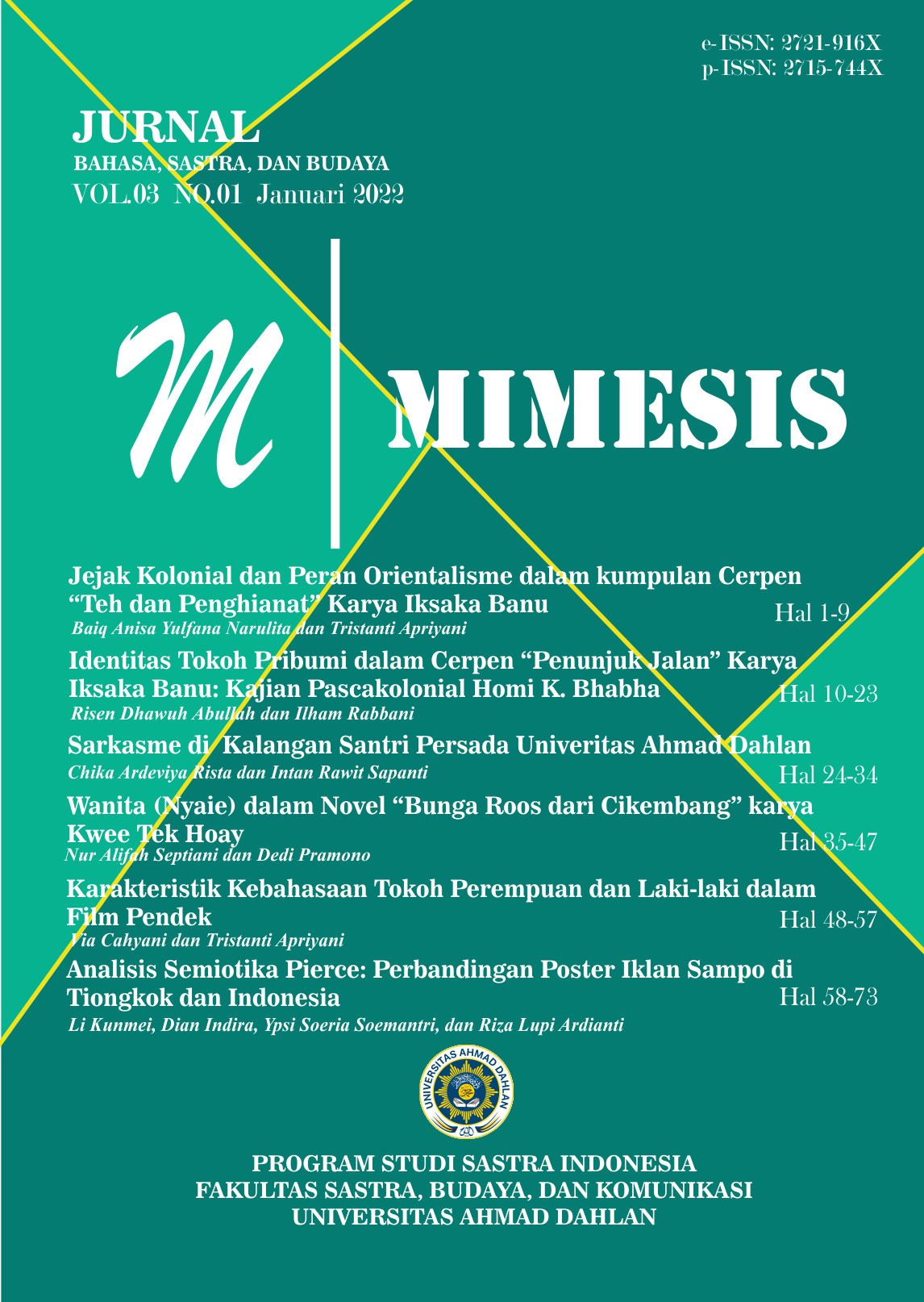SARKASME DI KALANGAN SANTRI PERSADA UNIVERSITAS AHMAD DAHLAN
DOI:
https://doi.org/10.12928/mms.v3i1.5040Keywords:
Sarcasm, Santri, Persada UAD, SociolinguisticsAbstract
This research is motivated by the importance of understanding the forms of sarcasm uttered by students so that the public knows the purpose of using sarcasm. The problems discussed in this study are (1) the form of sarcasm used by Persada UAD 2019/2020 students based on grammar, (2) the form of sarcasm used by Persada UAD 2019/2020 students based on the content of the speech, and (3) the factors causing Persada UAD students to use the form of sarcasm. This study aims to describe the form of sarcasm among Persada UAD students and find out the factors causing Persada students to use sarcasm among Persada UAD students. Based on the research results regarding the form of using sarcasm by Persada UAD students in 2019/2020, the following conclusions were obtained. (1) The use of sarcasm among the students of Persada UAD in 2019/2020 based on the grammatical basis was found in three forms, namely words, phrases, and clauses. (2) The use of forms of sarcasm among Persada UAD students in 2019/2020 based on the content of the speech found seven forms of sarcasm, namely words containing bitterness, bitter reproaches, expressions of anger, swearing, words that are not pleasant to hear, ridicule, and certain social varieties. (3) The factors causing the students of Persada UAD in 2019/2020 to throw sarcasm found ten factors, namely social background, habits, reflexes, anger, inappropriate place and time, inappropriate participants, goals that did not match the speaker, tone when conveying messages, media language, and norms in interaction.
References
Halliday, M. (2004). An Introduction to Functional Grammar (4 ed.). New York: Oxford University Press.
Halliday, M., & Matthiessen, M. (2014). Halliday's Introduction to Functional Grammar (4 ed.). New York: Hodder Arnold.
Fairclough, N. (1995). Critical Discourse Analysis: The Critical Study of Language. London: Longman Group Limited.
Dijk, T. V. (2004). Critical Discourse Analysis. In D. Schriffin, D. Tannen, & H. E. Hamilton, The Book of Discourse Analysis (pp. 352-371). Oxford: Blackwell.
Silaswati, D. (2019). Analisis Wacana Kritis Dalam Pengkajian Wacana. METAMORFOSIS: Jurnal Bahasa, Sastra Indonesia dan Pengajarannya, 12(1), 1-10.
Paltridge, B. (2012). Discourse Analysis: An Introduction. London and New York: Bloomsburry Academic.
Jorgensen, M., & Phillips, L. J. (2002). Discourse Analysis as Theory and Method. London: Sage Publications.
Rumata, V. M., & Elfrida, S. V. (2019). Ideologi dan Kekuasaan Pemerintah di Balik Wacana Pembangunan Tol Laut – Analisis Wacana Kritis Terhadap Materi Siaran DBU LPP RRI Sorong, 20 Oktober 2017. Jurnal Penelitian Komunikasi dan Opini Publik, 23(2), 90-103.
Anggito, A., & Setiawan, J. (2018). Metodologi Penelitian Kualitatif. Jawa Barat: CV. Jejak.
Suswandi, I. (2020). Representasi Kelugasan Beranda Laman www.covid-19.go.id: Tinjauan Analisis Wacana Kritis. Mimesis, 1(2), 21-43.
Wiratno, T. (2018). Pengantar Ringkas Linguistik Sistemik Fungsional. Yogyakarta: Pustaka Pelajar.
CNNIndonesia. (2021). Isi Maklumat Kapolri tentang Larang Simbol FPI di Masyarakat. Retrieved January 6, 2021, from https://www.cnnindonesia.com/nasional/20210101110207-12-588432/isi-maklumat-kapolri-tentang-larang-simbol-fpi-di-masyarakat.
BBCNews Indonesia. (2021). Pemerintah larang kegiatan FPI, polisi larang masyarakat unggah dan sebarkan konten terkait FPI. Retrieved Januari 5, 2021, from https://www.bbc.com/indonesia/indonesia-55481350.
Chaer, A. (1994). Linguistik Umum. Jakarta: Rineka Cipta.
Alwi, H. (1992). Modalitas dalam Bahasa Indonesia. Yogyakarta: Kanisius.
Eggins, S. (2004). An Introduction to Systemic Functional Linguistics (2 ed.). New York: Continuum.
Eriyanto. (2001). Analisis Wacana: Pengantar Analisis Teks Media. Yogyakarta: LKiS.
Martin, J., Matthiessen, C., & Painter, C. (1997). Working with Functional Grammar. London: Arnold.
Saragih, A. (2007). Fungsi Tekstual dalam Wacana: Panduan Menulis Rema dan Tema. Medan: Balai Bahasa.
Bloor, T., & Bloor, M. (2004). The Functional Analysis of English: A Halllidayan Approach. London: Arnold.
Fairclough, N. (2013). Critical Discourse Analysis: The Critical Study of Language (2 ed.). London: Routledge.
Tempo.co. (2021). UU Ormas Dasar Pembubaran FPI Bermasalah karena Hilangkan Mekanisme Peradilan. Retrieved January 6, 2021, from https://nasional.tempo.co/read/1418960/uu-ormas-dasar-pembubaran-fpi-bermasalah-karena-hilangkan-mekanisme-peradilan/full&view=ok.
Wodak, R., & Meyer, M. (2008). Methods of Critical Discourse Analysis (2 ed.). London and Canada: Sage Publishing.
Fairclough, N. (2002). The dialectics of discourse. TEXTUS, 14(2), 3-10. Retrieved from http://www.ling.lancs
Halliday, M., & Matthiessen, M. (2004). Halliday's Introduction to Functional Grammar (3 ed.). UK: Hodder Education.
KompasTV. (2020). FPI Dilarang, Ini 7 Poin Larangan dari Pemerintah Indonesia. Retrieved December 26, 2020, from https://www.kompas.tv/article/134178/fpi-dilarang-ini-7-poin-larangan-dari-pemerintah-indonesia.
Wiratno, T., & Santoso, R. (2011). Pengantar Linguistik Umum. Tangerang Selatan: Universitas Terbuka.
Downloads
Published
Issue
Section
License
Copyright (c) 2022 Chika Ardeviya Rista

This work is licensed under a Creative Commons Attribution-ShareAlike 4.0 International License.
License and Copyright Agreement
In submitting the manuscript to the journal, the authors certify that:
- They are authorized by their co-authors to enter into these arrangements.
- The work described has not been formally published before, except in the form of an abstract or as part of a published lecture, review, thesis, or overlay journal.
- That it is not under consideration for publication elsewhere,
- That its publication has been approved by all the author(s) and by the responsible authorities tacitly or explicitly of the institutes where the work has been carried out.
- They secure the right to reproduce any material that has already been published or copyrighted elsewhere.
- They agree to the following license and copyright agreement.
Copyright
Authors who publish with Mimesis agree to the following terms:
- Authors retain copyright and grant the journal right of first publication with the work simultaneously licensed under a Creative Commons Attribution License (CC BY-SA 4.0) that allows others to share the work with an acknowledgment of the work's authorship and initial publication in this journal.
- Authors are able to enter into separate, additional contractual arrangements for the non-exclusive distribution of the journal's published version of the work (e.g., post it to an institutional repository or publish it in a book), with an acknowledgment of its initial publication in this journal.
- Authors are permitted and encouraged to post their work online (e.g., in institutional repositories or on their website) prior to and during the submission process, as it can lead to productive exchanges, as well as earlier and greater citation of published work.












